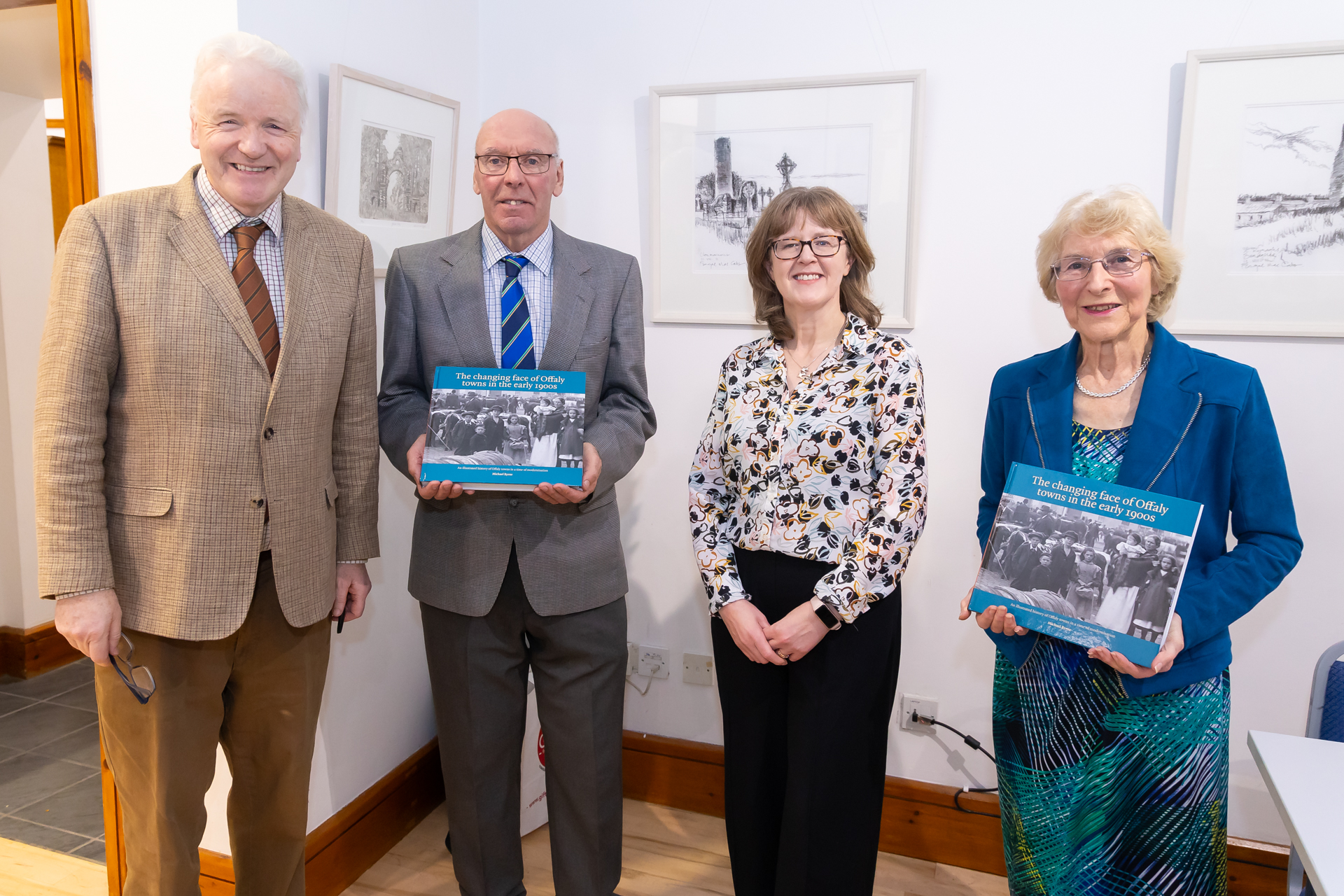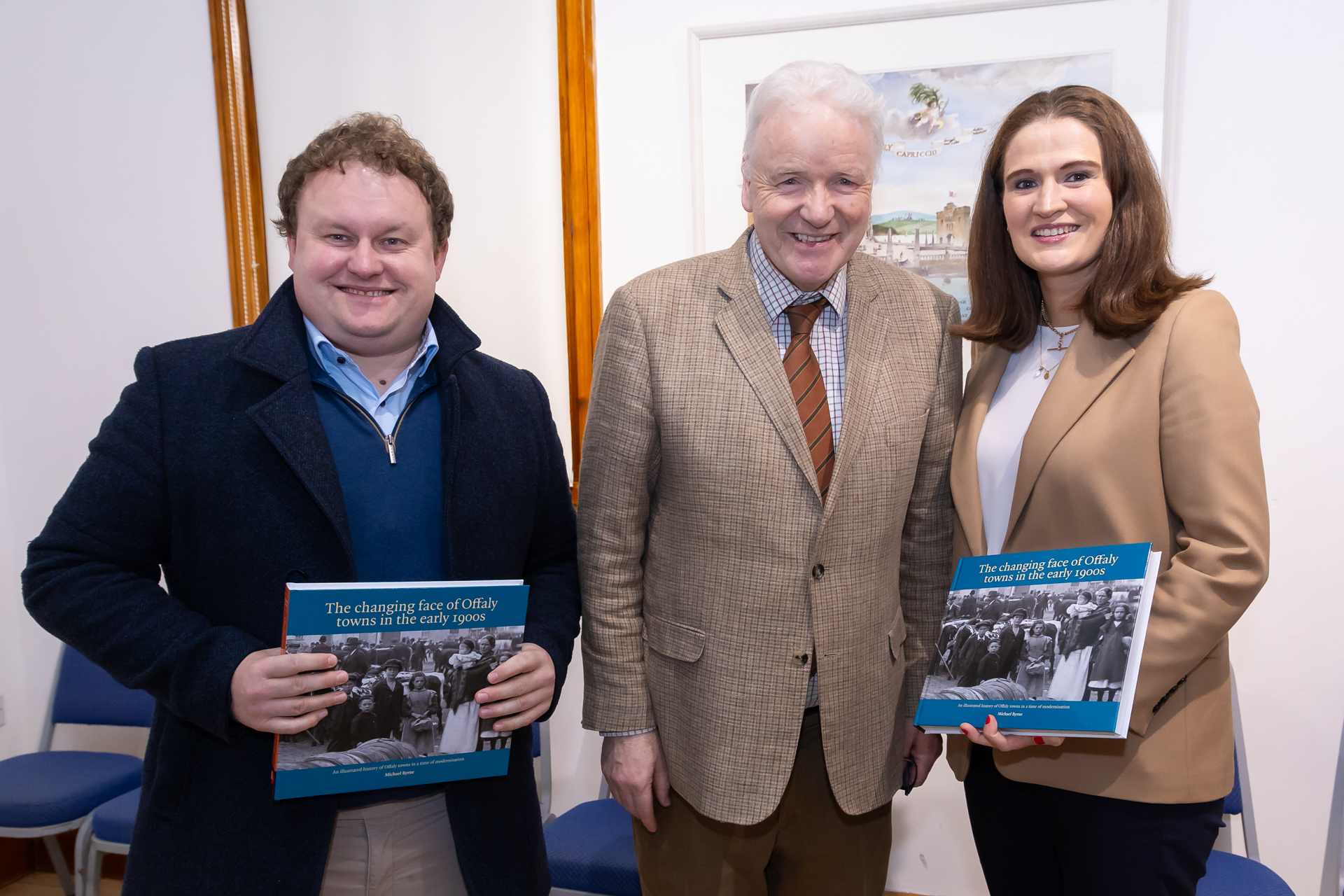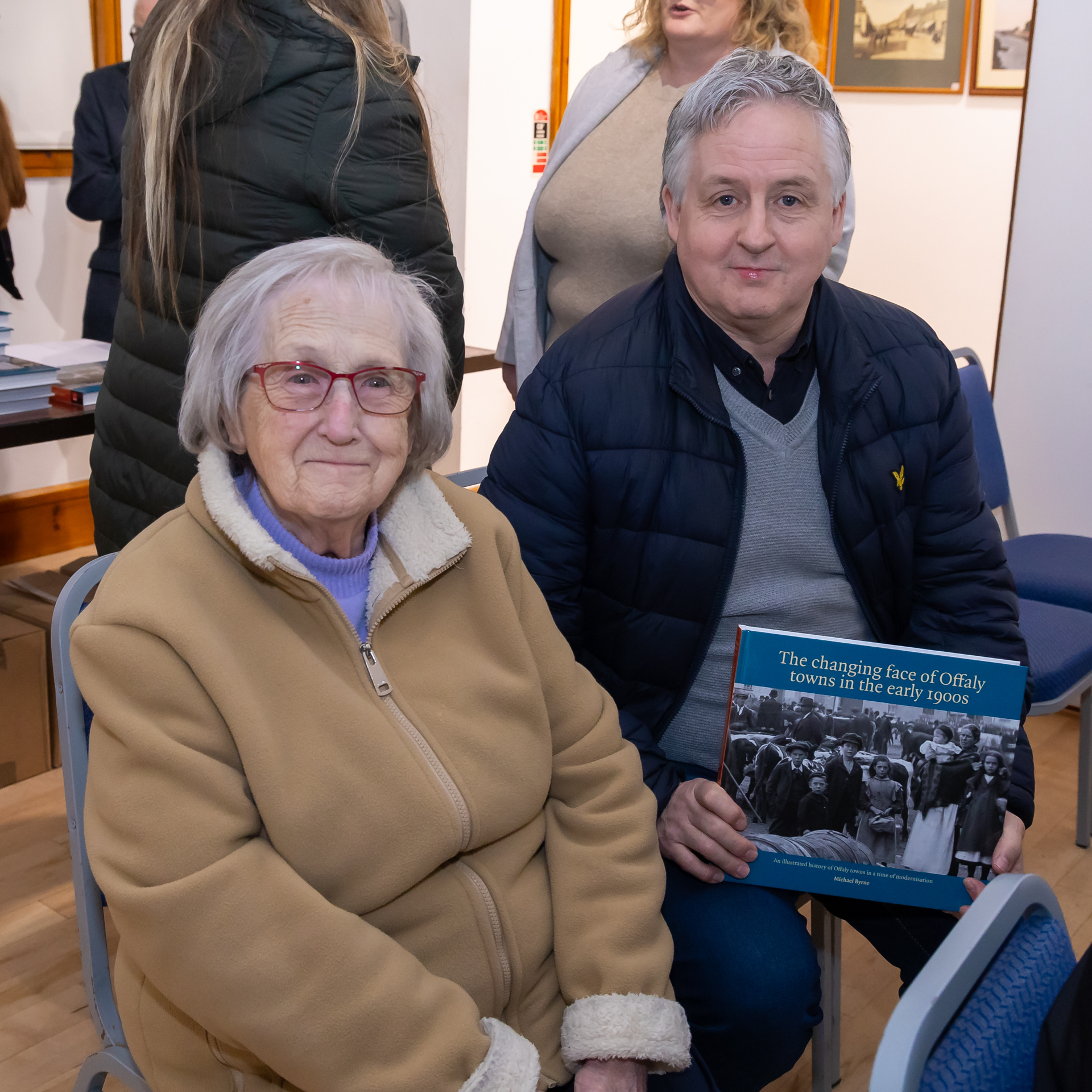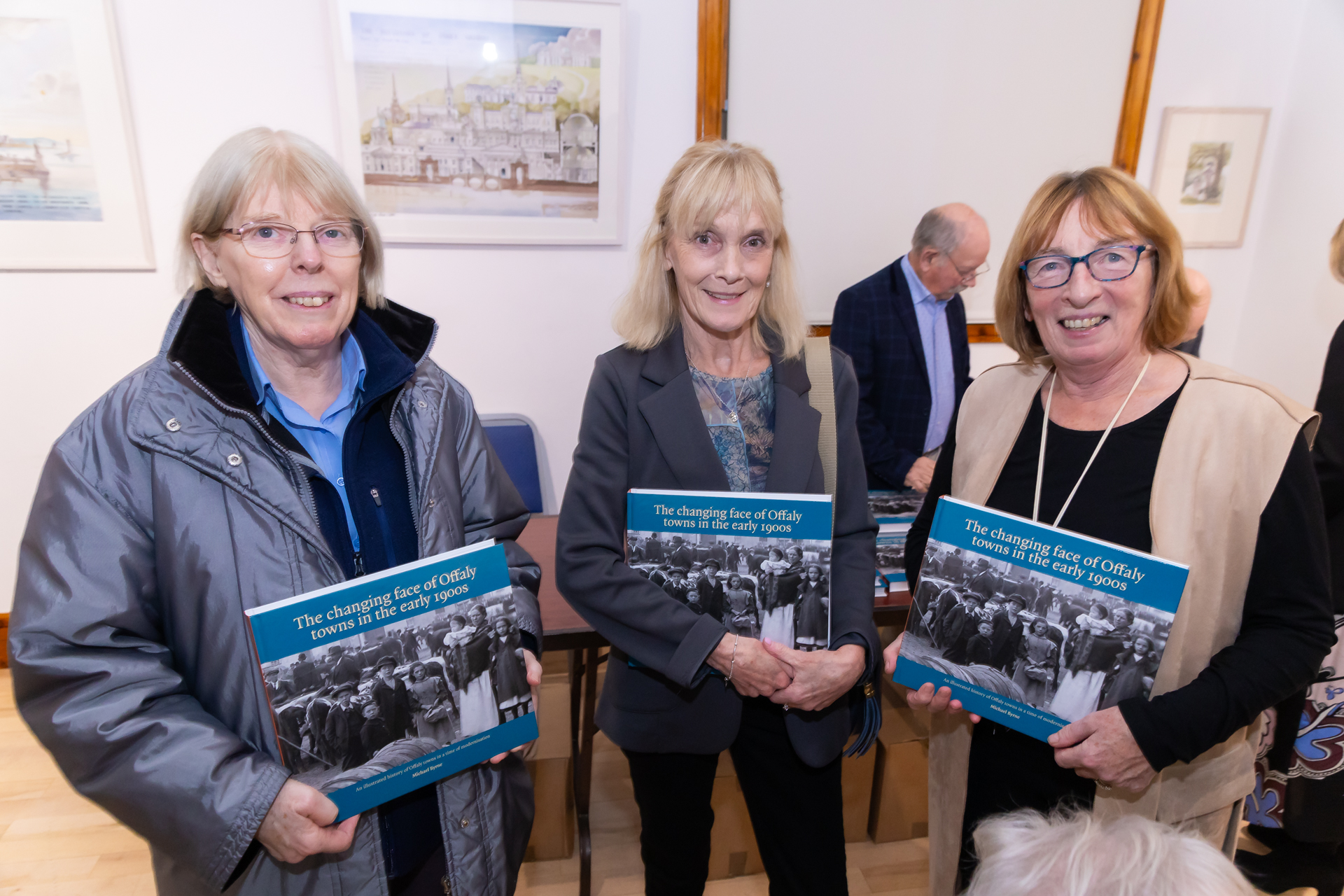
Editor Michael Byrne and contributors to the new book
Offaly's first citizen launches major new history publication
HISTORIAN and prolific writer and editor, Michael Byrne has been described as a "hidden gem" at the launch of his latest volume.
Speaking at the launch of this major new publication which Mr Byrne edited - "The changing face of Offaly towns in the early 1900s" – the Cathaoirleach of Offaly County Council, Cllr Tony McCormack, said Mr Byrne's enthusiasm for local history was infectious.
"To paraphrase the slogan for Offaly tourism Michael is truly a hidden gem", declared the General Election candidate to a full house at the launch in Offaly History Centre, Tullamore.
'The changing face of Offaly towns in the early 1900s' is an illustrated history of Offaly towns in a time of modernisation and innovation, explained Mr Byrne in a lengthy address.

He paid tribute to the work of the contributors to the publication from right around the county - Paul Barber, Stephen Callaghan, Grace Clendennen, Kevin Corrigan, Michael Goodbody, Ger Murphy, John Powell, Laura Price, Ciaran Reilly and Brendan Ryan – some of whom spoke at the launch.
Tribune sports editor, Kevin Corrigan gave a stimuating overview of his chapter on sport in the county, in particular the emergence of the GAA as the dominant sporting force.
He said the Tribune was a staunch supporter of the emerging nationalist sporting organisation. When attempts were made to form a hockey club in Birr, the Tribune thundered that the sport would most likely be championed by "effeminate British dandies", outlined Mr Corrigan to laughter from the attendance at the launch.

Grace Clendennen, who penned the chapter on Kinnitty, revealed that the census records of 1901 and 1911 showed a tight-knit yet diverse community, with locals and new residents arriving from across Ireland, and even from as far as Philadelphia and Australia.
"The village was home to shopkeepers, farmers, teachers, shoemakers, and a variety of other trades that kept daily life running. Together, they shaped the local economy and forged connections within the parish," added Ms Clendennen
"One of the highlights of village life in the first half of the 20th century was Fair Day. Held twice a year, these events were about more than just buying and selling livestock. They were social gatherings that brought people together from long distances, with farmers, buyers, and jobbers filling the village. Fair Day was such a significant occasion that the local school closed so children could help out. "

"Like the rest of Offaly," outlined Shannonbridge contributor, Laura Price, the village "underwent a lot of change in the early 1900s. the 1851 census recorded 398 people in the village, when there was a constabulary barracks and an army barracks , along with workers employed by the Shannon commissioners to improve the bridge and river. In the 1850s and a steady decline ensued."
She added: "It is impossible to talk about Shannonbridge without talking about the river. It was the main artery bringing goods to and from the village up until the 1960s. Barges, packet boats, and steamers stopped there delivering and collecting goods. Emigrants departed from the quay on the first leg of their journey abroad and many a sad parting must have occurred there."

Stephen Callaghan, who contributed the chapter on Crinkill, said the former British Army barracks there dominated the village's economy and that of the neighbouring town of Birr.
Ger Murphy, from outside Shinrone, who looked at the scene in the south Offaly villages of Dunkerrin, Moneygall and Shinrone, spoke on the lives of the labouring classes from tracts saved in the archives of the Folklore Commission.
Editor Michael Byrne said his own contribution to the book was the general essay on the changing face of Offaly towns, 1900-23, together with focuses on Ballinagar, Daingen, Kilcormac, Tullamore and some other villages and country houses.
He extended thanks to the manager of the Offaly History Centre, Breda Kelly, to all staff and to photographer Padraic Seery who worked last year on high resolution scans of all the old postcards. "My thanks also to Orla Connaughton, archivist with Offaly Archives, Offaly County Library for the use of an album they secured at some auction years ago and to the National Library of Ireland who were very helpful with the all-important Lawrence and Eason collections."

He also extended thanks to his wife Geraldine, son Diarmuid, daughter Eavan and his four grandchildren for their help.
Mr Byrne said the design of the volume was with Ferbane native, Sean Connolly of Power Designs. " I first worked with him on Legal Offaly [2008]; Tullamore: a portrait [ 2010] and The photographs of Middleton Biddulph in 2021. A very great thanks is due to him and to his business partners for putting up with me the past year.
He continued: "This is the first book to provide a photographic record of the towns and villages in County Offaly (former King’s County) in a time of tremendous political, social and economic from 1900 to 1923. The essays with each chapter are intended to provide context for the evolution of each town. An introductory essay provides an essential overview and identifies themes for further research. Almost 380 carefully captioned photographs from the early years of street photography have been selected. These are to accompany the essays by a panel of local historians, our contributors, all of whom have bought years of experience to their chosen town or village. The level of urban improvement from the years 1900-1923 had not been experienced since the decades prior to the famine times of the 1840s. By the early 1920s that period of growth, coinciding with the new century, was largely over and was not seen again until the Lemass economic reforms of the early 1960s."
Mr Byrne stressed there was very much a need for this book. "This is an image driven age and time is scarce. Changing faces provides to take stock of how far we have travelled since 1900, a time when there was no public utilities save gas lighting in the larger towns and the availability of rail service and good postal services."
"The changing face of Offaly in the early 1900s" is available at the Offaly History Centre and in shops around the county. It would make an ideal Christmas gift.
Subscribe or register today to discover more from DonegalLive.ie
Buy the e-paper of the Donegal Democrat, Donegal People's Press, Donegal Post and Inish Times here for instant access to Donegal's premier news titles.
Keep up with the latest news from Donegal with our daily newsletter featuring the most important stories of the day delivered to your inbox every evening at 5pm.